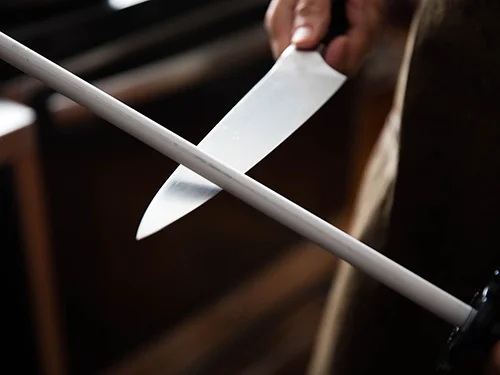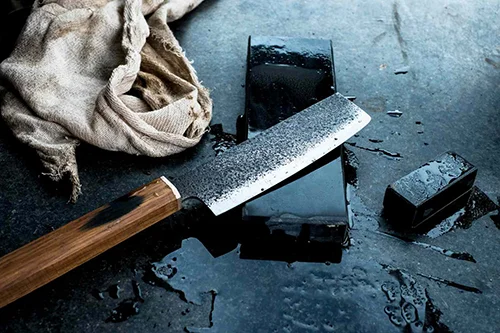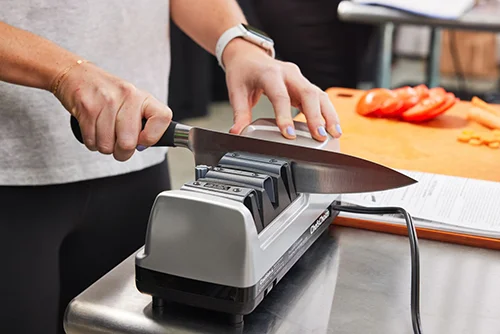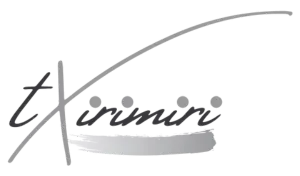One of the most crucial items in your toolbox as a chef is your knife. A sharp knife increases your kitchen productivity while also enhancing the precision and safety of your cuts. Every chef should be proficient in the essential art of regularly sharpening their knives. We’ll go through crucial knife sharpening methods in this article to maintain your blades razor-sharp to be prepared for any culinary task.
The need for sharp knives
Let’s first examine the importance of sharp knives in the kitchen before moving on to the techniques:
1. Knives that are sharp help you work more quickly and effectively. They cut through ingredients with ease, minimizing prep time and allowing you to concentrate on the culinary talent.
2. Control and precision: A sharp knife gives you better control over your cuts, enabling you to make slices that are more consistently exact. When working with sensitive substances or complex processes, this is especially crucial.
3. Contrary to popular opinion, using sharp knives is safer than using dull ones. Less force is needed with a sharp blade, which lowers the risk of slips and accidents. On the other hand, dull blades can easily slip off the meal and result in unforeseen injuries.
Techniques for sharpening knives
Honing as opposed to sharpening:

While sharpening entails removing metal to produce a new edge, honing involves realigning the blade’s edge. Between sharpenings, honing keeps the knife’s edge sharp.
Honing rod: Gently realign the knife’s edge with a honing rod. The knife’s heel should be pressed up to the top of the rod while holding the rod upright. Draw the knife down the rod at a 20-degree angle, using steady pressure.
It is advised to maintain an edge alignment before or after each use.
For more information about honing rods, watch this video!
Cutting stones:

Whetstones are classic sharpening implements with grit sizes ranging from coarse to fine. For a polished edge, start with a coarse grit (like 1000) and work your way up to finer grits (like 3000, 6000).
Preparing the stone: Soak the whetstone in water for 10 to 15 minutes before use. Water keeps the stone lubricated and keeps the blade from overheating.
Technique: Apply uniform pressure while running the knife across the stone while holding it at a constant angle (often 20 degrees). Repeat the process on both sides of the blade, switching between grits.
Final touches: To polish the edge and get rid of any burrs after sharpening, use a leather strop or a honing rod.
Sharpeners for electric knives:

Electric knife sharpeners are simple to use and can easily give your blades a sharp edge again. For convenience, they frequently have pre-set angles.
Instructions: Carefully read the manufacturer’s instructions and take the actions advised for your particular sharpener model. The sharpening slots are often used a few times with the blade, gradually moving from coarse to fine grits.
Electric sharpeners are practical, but they also remove more metal than conventional techniques. To prolong the life of your blades, it is crucial to use them sparingly and not rely primarily on electric sharpening.
Advice on maintaining knives
Proper knife maintenance, in addition to routine sharpening, is essential for extending their shelf-life and maintaining their best performance.
Always wash your knives by hand in warm water and mild dish soap. Avoid soaking them or putting them in the dishwasher since the blades might be harmed by abrasive detergents and excessive heat.
Proper knife storage: To prevent the edges from becoming dull or chipped, store your knives in a knife block, on a magnetic strip, or in blade protectors. They can get scratched or injure someone if you store them in a drawer with other cutlery.
Cutting surfaces: To reduce blade wear, use hardwood or plastic cutting boards. Cutting on glass or other hard surfaces should be avoided as they will quickly dull your blades.
Have fun cooking!
Every chef should possess the essential ability of knife sharpening. You improve your productivity, accuracy, and safety in the kitchen by keeping your knives sharp. Regular maintenance and appropriate storage are crucial for maintaining your blades, whether you prefer using a rod, whetstones, or electric sharpeners. Therefore, polish your knives, hone your talents, and raise the bar on your culinary masterpieces.
Stay tuned for more restaurant tips from the team at Tableo – Your trusted restaurant reservation system!

Unlock the tips that will help you stand out from the crowd and get more bookings!

Learn how to save time, reduce stress and fill your restaurant while you sleep!

Stephanie Paris
Gen-Z marketing coordinator bringing fresh energy to web and graphic design, with a weekend habit of chasing adventure.

Stephanie Paris
Gen-Z marketing coordinator bringing fresh energy to web and graphic design, with a weekend habit of chasing adventure.









